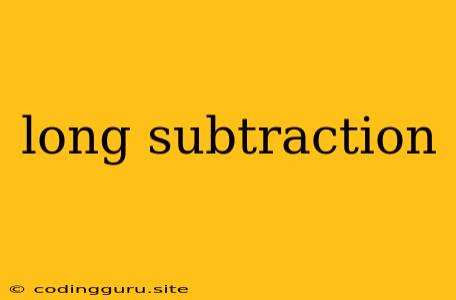Long Subtraction: A Step-by-Step Guide
Long subtraction is a fundamental arithmetic operation that helps us find the difference between two numbers, especially when they are large or involve multiple digits. It's a skill that's essential for everyday life, from calculating change at the store to balancing your budget. This guide will walk you through the process of long subtraction step-by-step, making it easy to understand and master.
Understanding the Basics
Before diving into the steps, let's clarify some key terms:
- Minuend: The larger number from which we subtract.
- Subtrahend: The smaller number that is being subtracted.
- Difference: The result of subtracting the subtrahend from the minuend.
Steps for Long Subtraction
-
Set up the Problem: Write the minuend above the subtrahend, aligning the digits by their place value (ones, tens, hundreds, etc.).
For example:
5432 - 2178 ------ -
Subtract the Ones Place: Start by subtracting the ones digit of the subtrahend from the ones digit of the minuend.
In our example:
5432 - 2178 ------ 4 -
Subtract the Tens Place: Move to the tens place and subtract the tens digit of the subtrahend from the tens digit of the minuend.
Continuing our example:
5432 - 2178 ------ 54 -
Subtract the Hundreds Place: Repeat the process for the hundreds place.
5432 - 2178 ------ 254 -
Subtract the Thousands Place: Finally, subtract the thousands digit of the subtrahend from the thousands digit of the minuend.
5432 - 2178 ------ 3254
Dealing with Borrowing
Sometimes, you'll encounter situations where the digit in the minuend is smaller than the corresponding digit in the subtrahend. This is where borrowing comes into play.
- Borrowing from the Next Place Value: When you need to borrow, look at the digit to the left of the current place value. "Borrow" 10 from that digit, adding it to the current digit. Reduce the digit you borrowed from by 1.
Example:
342
- 175
------
Here, we can't subtract 5 from 2 in the ones place. So, we borrow 10 from the tens place (4). This makes the ones digit 12.
342
- 175
------
7
Now, we can subtract 5 from 12, resulting in 7. Remember to reduce the tens digit by 1, making it 3.
Continue the subtraction process as before, borrowing whenever necessary.
Tips for Success with Long Subtraction
- Practice Makes Perfect: The more you practice, the more comfortable you'll become with the steps involved in long subtraction.
- Visual Aids: Use visual aids like number lines or manipulatives to help understand the concept of borrowing.
- Check Your Work: Always double-check your answers. You can do this by adding the difference to the subtrahend; the result should equal the minuend.
Examples
Here are a few more examples of long subtraction problems:
7895
- 3246
------
4649
9000
- 1234
------
7766
567
- 298
------
269
Conclusion
Long subtraction is a fundamental skill that can be mastered with practice and understanding. By following the steps outlined in this guide and using the helpful tips provided, you'll be able to confidently tackle any long subtraction problem you encounter.
